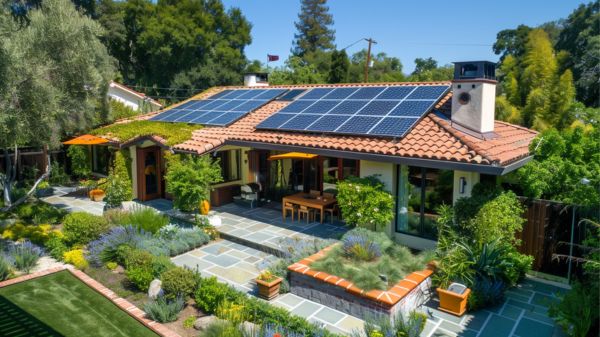Have you ever heard the saying, ‘Two birds, one stone’? Well, that’s exactly what green technology does for us when it comes to energy efficiency.
It not only helps us reduce our impact on the environment, but it also allows us to use energy more efficiently. Green technology focuses on finding cleaner and more sustainable ways to produce energy, using alternative fuels and implementing practices that minimize waste and greenhouse gas emissions.
By embracing green technology, we can conserve natural resources, reduce our carbon footprint, and pave the way for a more sustainable future.
So, join us as we explore the essential role of green technology in achieving energy efficiency goals and creating a greener, more energy-efficient world for all of us.
Environmental Benefits of Green Technology
One of the key environmental benefits of green technology is its ability to significantly reduce greenhouse gas emissions. Green technology promotes energy efficiency and helps in reducing energy consumption, which directly translates to lower greenhouse gas emissions and a smaller carbon footprint.
By utilizing renewable energy sources such as solar and wind power, green technology enables us to shift away from fossil fuels and embrace a cleaner energy mix. This not only reduces our reliance on non-renewable resources but also helps in mitigating climate change.
Additionally, green technology plays a crucial role in sustainable computing, allowing us to use resources in an environmentally friendly manner. By adopting green technology practices, individuals and organizations can reduce their environmental impact and contribute to a more sustainable future.
Enhancing Energy Efficiency With Green Tech
By implementing green technology, we can enhance energy efficiency through various methods. Here are four ways in which green tech can contribute to improving energy efficiency:
- Power management features: Green technology offers advanced power management features that optimize energy consumption in electronic devices. These features help reduce energy wastage and increase overall efficiency.
- Renewable energy integration: Green tech promotes the use of renewable energy sources such as solar and wind power. By harnessing these sources, we can reduce our dependence on fossil fuels and significantly lower carbon emissions.
- Sustainable materials: Green technology encourages the use of sustainable materials in construction and manufacturing. These materials have a lower environmental impact and contribute to energy savings throughout their lifecycle.
- Electronic waste management: Proper disposal and recycling of electronic waste is an important aspect of green technology. By recycling electronic devices, we can recover valuable resources and reduce the energy consumption associated with manufacturing new products.
These methods demonstrate how green technology can play a crucial role in enhancing energy efficiency and reducing our environmental footprint.
Role of Green Technology in Sustainable Energy Solutions
Green technology plays a pivotal role in our pursuit of sustainable energy solutions. By implementing green technology, we can significantly reduce energy consumption and minimize our environmental impacts.
One of the key benefits of green technology is its ability to reduce carbon emissions. By harnessing renewable energy sources such as solar and wind power, we can transition to clean energy and reduce our reliance on fossil fuels.
Additionally, green computing practices, such as optimizing data centers and using energy-efficient devices, contribute to energy efficiency and sustainability.
Companies that prioritize green technology and focus on reducing their carbon footprint not only contribute to a cleaner environment but also position themselves as leaders in sustainability.
Green Technology Innovations for Energy Conservation
As we delve into the realm of energy conservation, it’s crucial to explore the innovative advancements in green technology. These innovations play a vital role in reducing energy consumption and minimizing environmental impacts.
Here are four noteworthy green technology innovations for energy conservation:
- Low-carbon construction: Sustainable buildings that use eco-friendly materials and emit minimal carbon. They’re designed to maximize energy efficiency and reduce carbon dioxide emissions.
- Carbon capture and storage: This technology removes carbon from the atmosphere and converts it into synthetic fuel, effectively reducing greenhouse gas emissions.
- Renewable energy storage: Long-term storage solutions enable the efficient utilization of energy generated by renewable sources like solar and wind power, ensuring a continuous supply of clean energy.
- Hydrogen fuel cell electric vehicles: These vehicles run on hydrogen, offering higher efficiency and zero emissions, making them an environmentally responsible alternative to traditional vehicles.
Importance of Green Technology in Achieving Energy Efficiency Goals
To effectively achieve energy efficiency goals, it’s imperative that we understand the vital role green technology plays in mitigating environmental impact and conserving natural resources.
Green technology is essential for reducing energy consumption and carbon emissions, as well as promoting renewable energy and sustainable practices. By implementing green technology solutions, businesses and individuals can significantly contribute to climate change mitigation and support environmental regulations.
One of the key advantages of green technology is its ability to generate energy savings. Energy-efficient technologies, such as LED lighting and smart thermostats, can reduce energy consumption, resulting in cost savings and reduced carbon emissions. Additionally, green technology enables the utilization of renewable energy sources, such as solar and wind power, which further reduces dependence on fossil fuels and contributes to a cleaner, more sustainable energy mix.
Furthermore, green technology helps businesses and industries meet environmental regulations by tracking and reducing their emissions. By adopting sustainable practices and implementing green IT solutions, companies can’t only comply with regulations but also enhance their brand image and demonstrate their commitment to environmental responsibility.
Conclusion
Green technology plays a vital role in promoting energy efficiency and addressing environmental challenges. By adopting sustainable practices and utilizing clean energy sources, we can minimize waste, conserve resources, and reduce greenhouse gas emissions.
Just like a well-tuned engine, green technology optimizes our energy use and reduces our carbon footprint. It’s through the innovation and implementation of green technology that we can achieve a sustainable and environmentally friendly future for generations to come.




